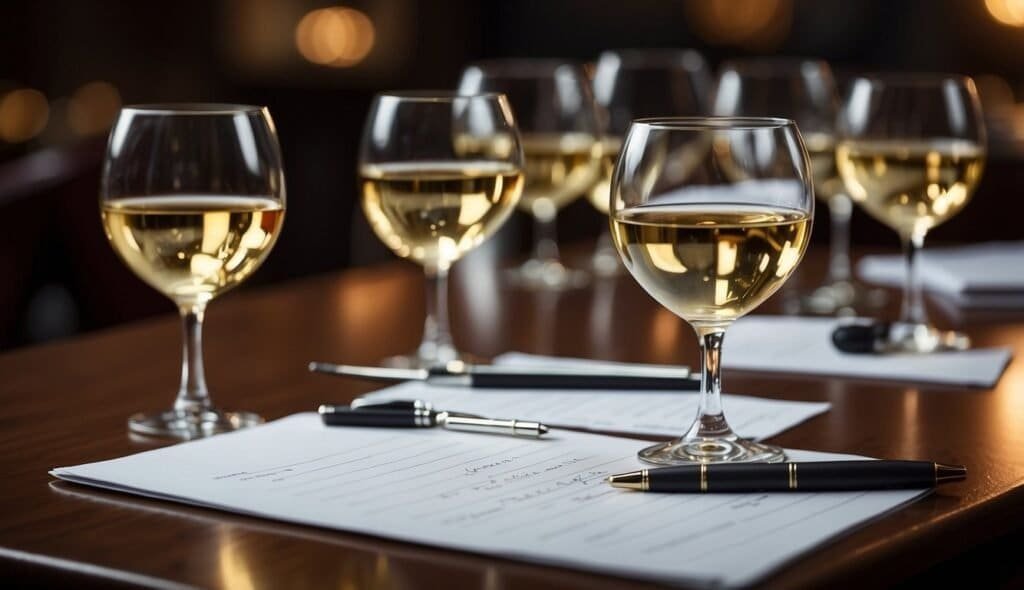This post may contain affiliate links. Please read my disclosure policy.
Ever wondered how to truly appreciate a glass of wine? Knowing the 5 S’s of wine tasting can transform your experience from a simple sip to an exciting exploration of flavours. This method is trusted by professionals and can help anyone start tasting wine like an expert.
The 5 S’s for wine tasting are See, Swirl, Sniff, Sip, and Savour. When you first see the wine, look at its colour and clarity. Hold your glass against a neutral background, ideally in natural light, to get the best view. A glass of Sauvignon Blanc from New Zealand will often exhibit a pale, straw colour, while a Shiraz from Barossa Valley might have a deep, rich hue.
Next, swirl the wine in your glass. This helps release its aromas. When you sniff the wine, take note of the different scents you can identify, like fruity notes in a Margaret River Cabernet Sauvignon. After that, sip the wine to taste its fruits, tannins, and acidity. Take your time to savour the flavours as they balance on your palate, and think about how they come together. This method enhances your enjoyment and understanding of wine, making your tasting experiences richer and more rewarding.
Understanding the Five S’s
The 5 S’s of wine tasting are essential for anyone wanting to appreciate wine deeply. These steps—See, Swirl, Sniff, Sip, and Savour—will help you identify a wine’s unique qualities.
The First S: See
The first step in the 5 S wine tasting process is to observe the wine’s appearance. Hold your glass up against a neutral background, such as a white tablecloth or wall. This makes it easier to evaluate the wine’s colour and clarity.
Different wines display various hues. For example, a white wine from Chardonnay grapes might appear pale yellow, while a Shiraz could show a deep ruby red. Clarity is another important factor. Clear wines are often well-filtered and free of unwanted particles.
By observing these aspects, you start to understand the wine before you even taste it. The visual inspection sets the stage for the entire tasting experience.
The Second S: Swirl
Swirling the wine in your glass increases its exposure to air, allowing you to assess its viscosity and release its aromas. This step is crucial in the 5 S’s of wine tasting.
The wine’s “legs” (or tears) indicate its alcohol content and sugar levels. High-alcohol wines produce thick, slow-moving legs, while low-alcohol wines have thinner, faster-moving ones.
Hold your glass by its base and move it in small circles. This can be done more easily on a flat surface. Swirling helps you get a fuller understanding of the wine’s bouquet—its unique combination of scents.
The Third S: Sniff
Sniffing the wine helps you identify its aromatic profile, one of the most important aspects of the 5 S’s in wine tasting. Deeply inhale the wine’s aroma to detect various scents.
Place your nose close to the glass and take several short sniffs. Typical aromas from Australian wines include citrus fruits in Sauvignon Blanc or dark berries in a Shiraz.
Different grape varieties and production methods contribute to distinct scents. Recognising these aromas can help you predict the wine’s taste and quality.
The Fourth S: Sip
Sipping the wine allows you to assess its flavours and texture. This step in the 5 S wine tasting method lets you explore the wine’s sweetness, acidity, tannins, and mouthfeel.
Take a small sip and let the wine coat your mouth. Pay attention to how it feels—smooth, rough, or somewhere in between. Notice how the initial taste evolves on your palate.
For example, a Pinot Noir might start with a fruity burst and finish with a delicate spice. This step provides the most direct insight into the wine’s character and balance.
The Fifth S: Savour
The final step, savouring, involves taking the time to enjoy and reflect on the wine’s aftertaste. After swallowing, note the finish—how long the flavours linger and whether they change.
A well-balanced Australian Cabernet Sauvignon might leave a lasting impression of dark fruits and subtle oak. Reflect on how the taste evolves, and compare this wine to others you have tasted.
This step brings together all the earlier observations and lets you appreciate the complexity and craftsmanship of the wine.

Examining Colour and Clarity
When tasting wine, two of the first things you should examine are its colour and clarity. These aspects can tell you much about the wine’s age, grape variety, and possible faults.
Visual Indicators of Quality
The colour of wine can provide key insights into its characteristics and quality. For red wines, hues range from deep purples to brick reds. Younger reds, like Australian Shiraz, often display a vibrant, dark colour. As red wines age, they typically lighten in colour. White wines, such as Hunter Valley Chardonnay, range from pale straw to golden yellow. A more golden colour usually indicates a well-aged or oak-aged wine.
Clarity is also important. Hold your glass against a neutral background, and observe the wine. High-quality wines are typically clear and bright. Cloudiness may suggest the presence of unwanted particles or improper storage. Sparkling wines, like Tasmanian sparkling, should have bubbles that are fine and consistent.
Identifying Wine Faults Through Sight
By examining the colour and clarity, you can also identify faults in the wine. An unusual brownish tint in red wines might indicate oxidation, which can occur if the wine is overly exposed to air.
For white wines, a golden or brown colour might suggest oxidation or age, but if it’s unexpectedly darker compared to its age or type, there could be a fault. Cloudiness in any wine could signal microbiological spoilage, such as the presence of bacteria. Sediments can be considered normal in aged wines, but in younger wines, it might point to a production issue.
Check for clarity to ensure the wine is free from haze, which can signal poor filtration or other faults. By carefully assessing these factors, you can make a more informed evaluation of the wine’s quality. For more detailed guidance, you can explore resources like this guide on the 5 S’s of wine tasting.
The Aromas of Wine

Discovering the aromas of wine adds a special layer to your wine-tasting experience. By using the 5 S’s for wine tasting, you can explore various scents and understand what they reveal about the wine’s origin and age.
Identifying Primary Aromas
Primary aromas mostly come from the grape itself and include fruits, herbs, and floral notes. When you swirl your glass of wine, you may smell berries or citrus if you’re tasting an Australian Shiraz or Chardonnay. These scents are typically the first ones you notice, and they help identify the type and quality of the grape.
For white wines like Australian Riesling, you might detect green apple, lemon, or lime. Red wines such as Cabernet Sauvignon often reveal blackcurrant or cherry. Sometimes, you can also pick up herbal notes like mint or eucalyptus, common in Australian varietals. The goal is to recognise these aromas as they offer clues about the wine’s profile.
Understanding Secondary and Tertiary Aromas
Secondary aromas develop during the winemaking process, especially during fermentation and ageing. For instance, Chardonnay aged in oak barrels may carry hints of vanilla, toast, or butter. These scents come from interactions between the wine and the barrel.
Tertiary aromas are the most complex, arising from extended ageing in the bottle. With time, an Australian Shiraz may develop earthy scents like leather, smoke, or even chocolate. These mature aromas indicate the wine’s evolution and add depth to your tasting experience.
Secondary and tertiary aromas enrich your sensory experience, making each sip more intriguing. Whether it’s the buttery smell of aged Chardonnay or the smoky undertones of an older Shiraz, recognising these aromas can greatly enhance your appreciation of the wine.
The Palate: Tasting and Textures

When tasting wine, focusing on the palate involves assessing various aspects such as sweetness, acidity, tannins, balance, body, complexity, and finish. Each element plays a role in the overall experience of the wine in your mouth.
Sweetness, Acidity, and Tannins
Sweetness in wine comes from residual sugars in the grapes. Australian Shiraz often has noticeable sweetness, which balances the wine’s bold flavours.
Acidity gives wine its crisp and refreshing qualities. It also helps balance sweetness. You can find high acidity in Australian Riesling, which provides a sharp, zesty taste.
Tannins contribute to the wine’s dryness and bitterness. They are more pronounced in red wines like Cabernet Sauvignon. Tannins can make the wine feel more structured and complex, drying out your mouth as you sip.
Assessing Balance and Body
Balance in wine suggests harmony between its components: sweetness, acidity, tannins, and alcohol. A well-balanced wine ensures no single element overwhelms the others. For example, an Australian Chardonnay often demonstrates a delightful balance of acidity and oakiness, making it pleasant to drink.
Body refers to the weight or mouthfeel of the wine, often described as light, medium, or full-bodied. A wine’s body can be influenced by its alcohol content, sugar, and grape variety. Pinot Noir from Australia typically has a lighter body compared to a robust Shiraz.
Complexity and Finish
Complexity in wine is about the layers of flavours as you taste. A complex wine may reveal fruit, spice, earthy notes, and more. Australian Grenache, for instance, can offer a range of aromas and tastes that evolve as you drink.
The finish is the lingering aftertaste once you’ve swallowed the wine. A longer finish often indicates a higher quality wine. Notable Australian varieties like a Barossa Valley Shiraz can leave a long, satisfying finish with hints of blackberries and pepper.
Understanding the palate during wine tasting allows you to appreciate the nuances and craftsmanship behind each bottle, enhancing your overall wine experience.
Evaluating and Recording Your Experience

Taking time to evaluate and record your wine tasting experience is crucial. This ensures you can track your preferences, identify nuances, and discuss your findings with others.
Taking Notes Effectively
To take effective notes during wine tasting, begin by focusing on the five S’s: sight, swirl, sniff, sip, and savour. Jot down observations for each step. For example, record the colour and clarity of the wine when you “see” it. Is it a deep red, like a Shiraz, or a pale yellow, like a Chardonnay?
When you “swirl”, note the wine’s viscosity. Does it leave long legs on the glass? During the “sniff” stage, write down the different aromas you detect. Does it remind you of berries, citrus, or oak?
“Sip” the wine and pay attention to the taste, texture, and body. Does it feel full, like a Barossa Valley Shiraz, or light, like a Hunter Valley Semillon? Finally, “savour” the finish and aftertaste. Is it long-lasting or does it fade quickly?
Discussing Wine with Others
Discussing wine with others enhances your tasting experience. Start conversations by sharing your tasting notes and asking for insights. For instance, you can compare your notes on a Yarra Valley Pinot Noir with those of your friends.
Share your thoughts on the aromas and flavours you detected. Did someone else find a hint of chocolate in their Shiraz? Discussing these details helps you learn and appreciate the complexity of wine.
Also, join local wine tasting clubs or forums. They offer opportunities to swap notes and try new varietals. Engaging with a community deepens your understanding and enjoyment of wine tasting.
Frequently Asked Questions
Understanding the basics and steps of wine tasting can enhance your experience significantly. Follow this guide to master the five S’s of wine tasting and assess the quality of Australian varietals effectively.
What are the essential steps to follow in wine tasting?
The essential steps in wine tasting include seeing, swirling, sniffing, sipping, and savouring. Each step helps you understand various aspects of the wine. The visual inspection allows you to see the wine’s colour, while swirling helps release its aromas.
How does one effectively assess the quality of wine during a tasting?
To effectively assess the quality of wine, focus on its clarity, aroma, taste, and aftertaste. Hold your glass against a neutral background to examine its clarity. Swirl and sniff to capture the aroma. Pay attention to the balance of sweetness, acidity, tannins, and overall mouthfeel when you sip.
What is the correct sequence to follow when sampling wine?
When sampling multiple wines, start with lighter wines such as Sauvignon Blanc and move towards heavier, more robust wines like Shiraz. This prevents the strong flavours from overwhelming your palate early on.
Can you list the fundamental elements to examine in a wine tasting session?
The fundamental elements to examine include the wine’s appearance, aroma, taste, and finish. For appearance, check the colour and clarity. The aroma requires you to identify different scent notes. Taste involves analyzing sweetness, acidity, bitterness, and tannins. The finish is how the taste lingers after you swallow.
How should one approach the tasting of multiple wines in one sitting?
When tasting multiple wines, it’s important to cleanse your palate with water or unsalted crackers between tastings. Start with whites and lighter reds before proceeding to heavier reds. This method allows you to appreciate the unique characteristics of each wine without the flavours blending.
Which techniques are crucial for a thorough evaluation of wine?
Crucial techniques include proper aeration, sniffing to capture the full bouquet, and slowly tasting to detect different flavours. Ensure you swirl the wine to release its aromas and take small sips to identify the precise balance of elements such as acidity, sweetness, and tannins in Australian varietals.
User Review
( votes)Sip smarter, subscribe now!
Subscribe for gourmet tips, event updates, travel ideas, and a free e-book on Food Pairings. Start your journey to culinary and travel excellence!













